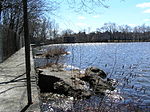Ward Acres Nature Preserve
Ward Acres is a 62-acre park in the Wykagyl section of the city of New Rochelle, in Westchester County, New York. Formerly part of a large country estate and horse farm, New Rochelle purchased the land in 1962 with help from the New York State Park and Recreation Land Acquisition Bond Act. Ward Acres provides residents with a unique park experience within a natural setting. Wooded areas are much the same as they had been over a century ago, and current park trails follow the alignment of the early horse farm's trails and drives. Stone walls which once defined pastures, the grave sites of Ward champion horses and three of the farm's main buildings still stand on the property.
Excerpt from the Wikipedia article Ward Acres Nature Preserve (License: CC BY-SA 3.0, Authors).Ward Acres Nature Preserve
Pinebrook Boulevard,
Geographical coordinates (GPS) Address Nearby Places Show on map
Geographical coordinates (GPS)
| Latitude | Longitude |
|---|---|
| N 40.958 ° | E -73.781 ° |
Address
Pinebrook Boulevard
Pinebrook Boulevard
10804
New York, United States
Open on Google Maps



